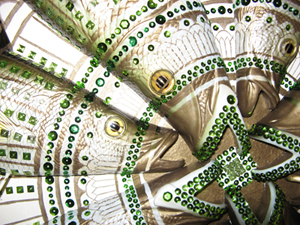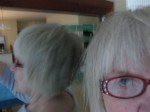Five on three
The Armoury Gallery
1718 N. lst St. (3N3)
Gallery hours: Fridays & Saturdays 1 – 5
Opening Reception: Friday, May 9, 7 – 10pm
info@thearmourygallery.com

Two decades have passed since I had a studio on floor five at the Fortress. I was painting BIG back then and recall lugging the results up and down the ancient freight elevator on the west side of the red brick building. The place was crawling with artists, some sneakily living in tandem with their work (one place even had a shower!), and though it was “illegal” to hunker down, it was more or less overlooked. Sax Arts & Crafts was on the street level fronting The Fortress at 1st and Pleasant. Those were the days, my friend. We thought they’d never end.
Eduardo J. Villanueva, Emily Siegel Belknap, Karin Haas, Cassandra Smith and Jessica Steeber: from May 9 – June 6, you can see what they’re up to. Their formal education in art is diverse: MIAD, UW-Milwaukee and Mount Mary College. They share a 1,000 sq.-ft-area centered by a furnace. Artist Jessica Steeber observed that a furnace in the middle of the floor actually gives them more wall space. Artists Villanueva, Belknap and Haas will exhibit until June 20th when they’ll give way to artists from Milwaukee, Chicago and Philadelphia. Smith and Steeber (co-owners of the gallery) are exhibiting for the grand opening, but Steeber says it’s likely they won’t exhibit their work in the future. This is a wise strategy if you run a gallery, because frankly, invited artists sometimes feel upstaged.
On my way to visit The Armoury, I was thinking that so much wall space is not necessarily a good thing for young artists accustomed to cramped spaces. It could lead to art that sprawls – but if it sprawls and it’s also interesting, that’s another thing entirely.

Of the five exhibitors, co-owner Steeber takes up the least amount of space with her discrete installations presented on traditional shelving unearthed at the Salvation Army, Michael’s Craft Store, and yes, her parents’ basement. The objects on the shelving consist of props (dollhouse furniture, tiny fake trees) and photographs designed to compare and contrast the artist’s shrunken world with our expanded universe. The claustrophobic boxes of Joseph Cornell come to mind as I study her efforts; so do scaled-down set-design models, and/or very personal objects arranged just so in homes across the land. It’s kitsch with a twist; it goes beyond decorative and into the miniaturized realm of juxtaposing objects in a thoughtful manner. The most successful installation joins a conservatively furnished imagined “room” (or “setting”) with a staircase leading to a surreal landscape where veggies sit on benches facing a lake. Using mirror-images produced via her photography, Steeber “reflects” dual worlds seamlessly, without smacking viewers over the head.
On the day I visited, printmaker Karin Haas was busy with a mechanical pencil, embellishing walls in an 8’ x 10’ cube-shaped space. Her work is obsessive and gorgeous in the manner of handmade lace, an intertwining of forms fused and refined. A lovely selection of steel-plate engravings (some priced at $450) were hung on the wall outside of the cubicle. I asked Haas if she was concerned about having her mechanical pencil drawings (no erasing allowed!) covered with paint when the exhibition closes. If you think about all her hours of work with a mechanical pencil, how could she not be concerned? She told me that its temporary nature never entered her mind. “It’s all about the process,” she said.
 Never have plastic fish covered in sequins and metallic paint looked so fascinating. Part Rococco, part Baroque, Cassandra Smith’s radial wall pattern is something to behold. The craftsmanship is exquisite; the content (a hybrid of Up North décor and over-the-top silliness) speaks of an artist gone wild. It’s refined – but it would rock in one of Donald Trump’s mansions, or maybe the Bellagio in Las Vegas. Some of the installation involves painted patterns on the wall behind the multiple fish. It’s all outrageous and wonderfully bizarre.
Never have plastic fish covered in sequins and metallic paint looked so fascinating. Part Rococco, part Baroque, Cassandra Smith’s radial wall pattern is something to behold. The craftsmanship is exquisite; the content (a hybrid of Up North décor and over-the-top silliness) speaks of an artist gone wild. It’s refined – but it would rock in one of Donald Trump’s mansions, or maybe the Bellagio in Las Vegas. Some of the installation involves painted patterns on the wall behind the multiple fish. It’s all outrageous and wonderfully bizarre.
The watercolors of White Whale Collective co-founder, Emily Siegel Belknap – panoramas and horizontal stretches of the sublime – made me think (again) about the quiet photographic landscapes of Tom Bamberger. The artist seems to have cleared her mind of all distractions while fusing meditation and boredom. So many watercolorists blow opportunities by wielding heavy handed concepts of flora and faun, you know the kind I mean: groaning gardens of peonies and roses, signifying nothing beyond groaning gardens of peonies and roses. There is none of that here. Her work is stripped-down and thoughtful, clean and contemporary.
The spanking brand new Armoury Gallery stands on the cusp. Can they make it as a gallery? Will their fairly priced art be enough to cover the monthly rent of $425, currently being covered by the co-owners paychecks? “I want it to be more than a place for me and my friends to hang-out,” Steeber says, adding that her folks are buying the beer and wine for the Grand Opening. Cassandra Smith’s mom is making the eats.
Before I left, I asked Steeber to define what “success” means to her. She said, after a long pause, that she thinks it means “being able to live off the sales of art.” Her dream for The Armoury Gallery is to create a dynamic between the invited artists and visitors. I’ve listened to that dream often in my long career and I never grow tired of the hopeful tale. It’s what makes young artists tick, keeps them working. The rest is in the lap of the gods. The signs are up and point the way. Be there Friday night. VS




















